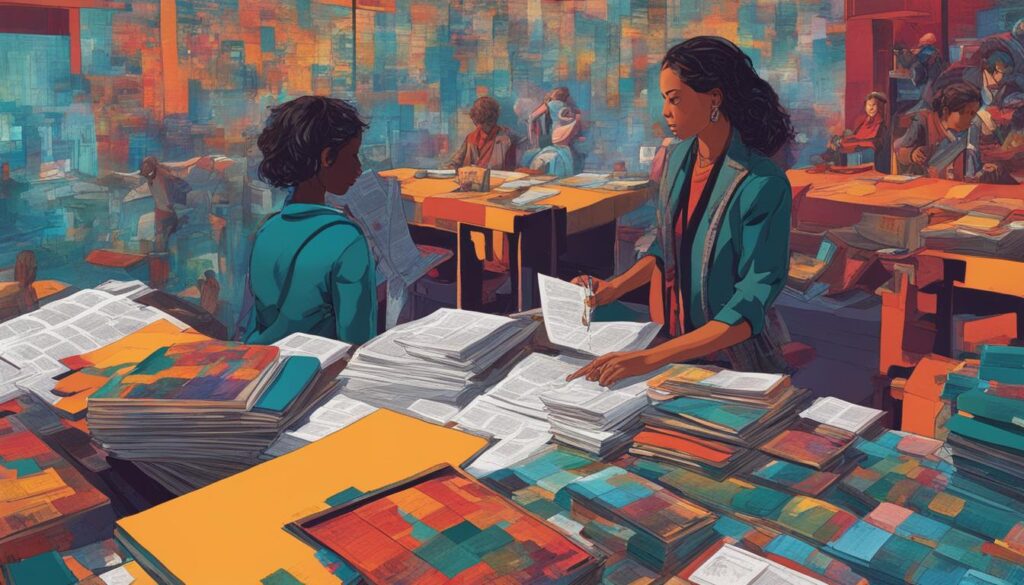
What is Narrative Journalism and How to Write it?
In today’s fast-paced world, where we are constantly bombarded with information, narrative journalism offers an immersive form of storytelling that captivates readers and sparks their imagination. Narrative journalism, also known as long-form storytelling or immersive reporting, is a form of nonfiction storytelling that focuses on presenting real-life events in a compelling narrative format.
At its core, narrative journalism combines the art of storytelling with the rigors of journalism. It aims to provide readers with an in-depth understanding of a topic or event by transporting them into the world of the story through vivid and descriptive language, character development, and plot structure. Narrative journalism is a powerful tool for journalists to convey complex information in an engaging and accessible manner and is a key component of long-form journalism.
In this section, we will explore the world of narrative journalism, its techniques, art, and how to effectively write compelling journalistic narratives. By the end of this section, you will have a solid understanding of narrative journalism and how to engage readers through in-depth storytelling.
Understanding Narrative Journalism
In this section, we will explore the origins, evolution, and key characteristics of narrative journalism. Narrative journalism is a style of in-depth reporting that utilizes immersive techniques to engage readers through long-form storytelling. It is a powerful tool for journalists, as it allows us to convey complex stories in an accessible and relatable manner.
The Origins of Narrative Journalism
Narrative journalism has been around for centuries, with early examples dating back to the 16th century. However, it wasn’t until the 1960s and 70s that narrative journalism became a recognized and respected form of journalism. This was due in large part to the work of writers like Truman Capote, who wrote the groundbreaking nonfiction novel “In Cold Blood.”
The Evolution of Narrative Journalism
Over the years, narrative journalism has evolved to encompass a wide range of styles and techniques. Today, it is used in everything from investigative reporting to sports journalism to personal essays. One of the hallmarks of narrative journalism is its focus on character development. By creating fully realized characters, journalists can draw readers in and keep them engaged throughout the story.
The Key Characteristics of Narrative Journalism
There are several key characteristics that define narrative journalism. These include:
- Immersive journalistic storytelling that draws the reader in
- Emphasis on character development and human interest
- Use of descriptive language to create vivid images in the reader’s mind
- Long-form storytelling that allows for in-depth journalism exploration of complex topics
The Role of Narrative Journalism in Engaging Readers
Narrative journalism is an incredibly effective way to engage readers. By using immersive techniques, journalists can create compelling narratives that draw readers in and keep them engaged. This is particularly important in today’s digital age, where readers are bombarded with information and have short attention spans. Narrative journalism allows us to tell stories in a way that captures readers’ attention and keeps them reading until the end.
Techniques for Writing Compelling Narratives
At the heart of narrative journalism is the art of storytelling. As such, effectively conveying a compelling narrative is crucial to engage your audience and create an immersive experience for readers. In this section, we will explore the techniques used in narrative writing to achieve this.
Narrative Storytelling
Narrative storytelling is the foundation upon which compelling journalistic narratives are built. This involves constructing a story with a clear plot structure, well-developed characters, and vivid descriptions. By painting a vivid picture of the setting and characters in the reader’s mind, narrative storytelling draws readers into the story, making it more engaging.
To achieve this level of immersion, it is important to incorporate sensory details, such as sights, sounds, and smells, into your writing. By stimulating the reader’s five senses, you can transport them into the world of your story, creating a more realistic and engaging experience.
Long-Form Journalism
Long-form journalism is the genre in which narrative journalism thrives. By its very nature, long-form journalism allows for in-depth exploration of complex issues and enables writers to tell compelling stories. Long-form journalism offers the opportunity to explore a topic or issue in detail, allowing for a deeper understanding of the subject matter.
When writing long-form journalism, it is important to strike a balance between providing detail and maintaining the reader’s interest. This requires a careful consideration of pacing and structure. A well-crafted long-form narrative will keep the reader engaged from beginning to end.
Storytelling Journalism
Storytelling journalism is the perfect platform for narrative writing. By combining traditional journalistic practices with the art of storytelling, storytelling journalism creates a compelling reading experience while still providing accurate and factual reporting.
One technique commonly used in longform storytelling journalism is to focus on a particular character or group of people. This allows readers to attach themselves emotionally to the narrative, making it more engaging. By telling the story through the eyes of a particular individual, readers can better understand the impact of the events being reported.
The Art of Narrative Reporting
Investigative reporting is about more than just presenting facts; it’s about crafting a compelling story that engages readers and makes them care about the issue at hand. Narrative journalism is an essential tool for achieving this, using techniques such as character-driven journalism development, plot structure, and descriptive language to create a more immersive experience for the reader.
At the heart of successful narrative reporting is the ability to weave together complex information and present it in a way that is clear and easy to understand. It requires a deep understanding of narrative techniques, such as foreshadowing, pacing, and tone, as well as a strong grasp of the subject matter.
The key to effective narrative in-depth reporting is to keep the focus on the story, not the facts. By using narrative techniques to build tension, introduce conflict, and create a sense of urgency, you can draw readers into the world of your reporting and make the issue at hand feel real and immediate.
Narrative Techniques in Investigative Reporting
There are a number of narrative techniques that can be particularly effective in investigative reporting, including:
- Scene-setting: using vivid and descriptive language to transport readers to the setting of the story, making it feel more real and immediate.
- Characterization: creating fully-realized and compelling characters that readers can identify with and care about.
- Plot structure: using the traditional three-act structure of narrative storytelling to create a compelling arc for your reporting.
- Dialogue: using dialogue to bring characters to life and create a more immersive experience for the reader.
By employing these techniques, you can create a more engaging narratives and impactful piece of investigative journalism.
The Importance of Long-Form Storytelling
Long-form storytelling is a crucial element of narrative journalism, providing the space and depth required to fully explore complex issues and themes. Unlike traditional news reporting, which is often constrained by the need for brevity and immediacy, long-form narrative storytelling in news allows for a more nuanced and in-depth exploration of the subject matter.
By taking the time to fully develop characters, explore themes, and build tension, long-form narrative reporting can create a more satisfying and impactful experience for the reader. It allows for a deeper understanding of the issue at hand, and can help to contextualize complex topics in a way that is more accessible and approachable for readers.
By mastering the art of narrative style reporting and long-form storytelling, you can elevate your investigative journalism to a new level. By using techniques such as scene-setting, characterization, and plot narrative structure to create a fully realized and immersive experience for the reader, you can make your reporting more impactful and resonant.
Conclusion
In conclusion, narrative journalism is a powerful storytelling tool that allows journalists to engage readers through immersive reporting and compelling narratives. Through our exploration of the key concepts, techniques, and art of narrative journalism, we hope that you have gained valuable insights into this style of nonfiction storytelling.
To further inspire your own narrative writing, we have included some great narrative journalism examples. The New Yorker’s feature on a teenage climate activist, Greta Thunberg, is a powerful example of narrative nonfiction. The article blends elements of storytelling and investigative reporting to provide a comprehensive portrait of Thunberg’s activism and the broader climate movement. Another great example is Ta-Nehisi Coates’ “The Case for Reparations,” which draws on the history of racism and discrimination in America to make a compelling case for reparations.
Incorporating elements of narrative nonfiction into your own reporting can help you engage readers, provide depth and context to your stories, and make your reporting more accessible to a wider audience. We hope that this article has provided you with the tools and inspiration you need to embark on your own narrative journalism journey.
FAQ
What is narrative journalism?
Narrative journalism is a style of reporting that focuses on telling stories through a narrative lens. It incorporates storytelling techniques from fiction writing to create engaging and immersive narratives that captivate readers.
How is narrative journalism different from traditional journalism?
Traditional journalism typically focuses on delivering factual information in a concise and objective manner. Narrative journalism, on the other hand, emphasizes long form storytelling and utilizes techniques like character development and descriptive language to create a more immersive reading experience.
Why is narrative journalism important in long-form storytelling?
Narrative journalism is crucial in long-form storytelling because it helps to sustain the reader’s interest over an extended period of time. By creating a narrative arc with compelling characters, engaging plotlines, and a strong sense of atmosphere, narrative journalism keeps readers invested in the story from beginning to end.
How can I make my journalistic narratives more immersive?
To make your journalistic narratives more immersive, you can focus on using vivid descriptions, incorporating dialogue, and developing well-rounded characters. Additionally, employing techniques like pacing, suspense, and building tension can further immerse readers in the story.
What are some examples of narrative journalism?
Some well-known examples of narrative journalism include Truman Capote’s “In Cold Blood,” Hunter S. Thompson’s “Fear and Loathing in Las Vegas,” and Jennifer Egan’s “The Goon Squad.” These examples showcase the power of narrative storytelling in journalism and its ability to create impactful and memorable narratives.










